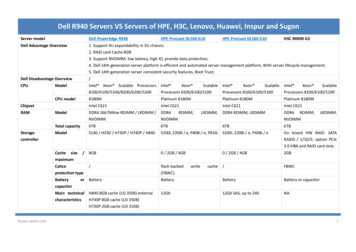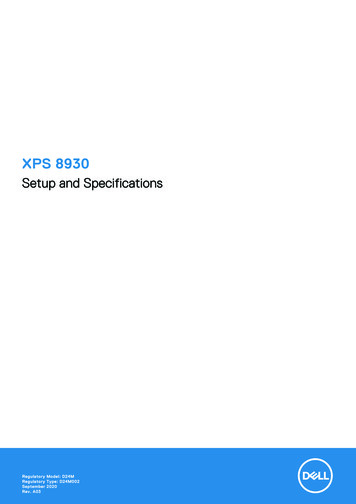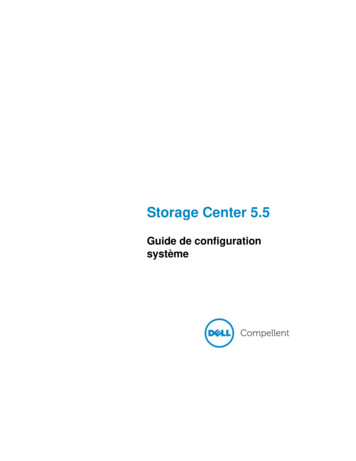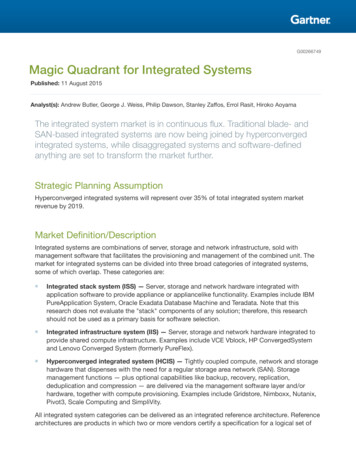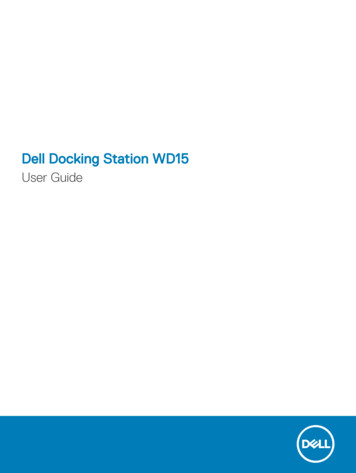
Transcription
Dell Docking Station WD15User Guide
Notes, cautions, and warningsNOTE: A NOTE indicates important information that helps you make better use of your product.CAUTION: A CAUTION indicates either potential damage to hardware or loss of data and tells you how to avoid the problem.WARNING: A WARNING indicates a potential for property damage, personal injury, or death.Copyright 2017 Dell Inc. or its subsidiaries. All rights reserved. Dell, EMC, and other trademarks are trademarks of Dell Inc. or its subsidiaries. Othertrademarks may be trademarks of their respective owners.2017 - 12Rev. A03
Contents1 Introduction.42 Package Contents .53 Hardware Requirements .74 Identifying Parts and Features . 85 Input/Output (I/O) Connectors. 116 Kensington Lock Slot.127 Important Information.13Updating the Dell Docking Station WD15 / Dell Thunderbolt Dock TB15 driver set. 13Updating the Graphics drivers for your computer.138 Quick Setup of Hardware . 159 LED Status Indicators. 17Power Adapter LED. 17Docking Status Indicator.1710 Configuring the Intel HD Graphics utility.1811 Removing the USB Type-C Cable . 2112 Troubleshooting the Dell Docking Station WD15. 26Symptoms and solutions. 2613 Technical specifications.28Docking Specifications . 28Display resolution table.30Contents3
1IntroductionThe Dell Docking Station WD15 is a device that links all your electronic devices to your computer using a USB Type-C cable interface.Connecting the computer to the docking station allows you to access all peripherals (mouse, keyboard, stereo speakers, external hard drive,and large-screen displays) without having to plug each one into the computer.CAUTION: Update your computer’s BIOS and the Dell Docking Station WD15 drivers to the latest versions available atwww.dell.com/support BEFORE using the docking station. Older BIOS versions and drivers could result your computer notrecognizing the docking station or not functioning optimally. Please see the Important Information chapter for detailedinstructions on how to update your BIOS and graphics card drivers before using the Dell Docking Station WD15.4Introduction
2Package ContentsYour docking station ships with the components shown below. Ensure that you have received all the components and contact Dell (seeyour invoice for contact information) if something is missing.Docking Station withUSB Type-C cablePower CordPower AdapterQuick Setup Guide(QSG)Package Contents5
Safety, Environmental,and RegulatoryInformation6Package Contents
3Hardware RequirementsBefore using the docking station, ensure that your laptop or PC has a DisplayPort over USB Type-C or Thunderbolt port.Hardware Requirements7
4Identifying Parts and FeaturesFigure 1. Identifying Parts and Features — FrontFigure 2. Identifying Parts and Features — Back8Identifying Parts and Features
Audio headset portUSB 3.0 port with PowerShareUSB 3.0 portPower Adapter LED IndicatorSleep/Wake up/Power buttonKensington Lock slotHDMI portMini DisplayPortVGA portNetwork connector (RJ-45)USB 2.0 portUSB 3.0 portIdentifying Parts and Features9
Line-outPower connectorNOTE:The dock button is designed to replicate your system's power button. If you connect the WD15 to supported Dell computers, the dockbutton will work like your computer's power button and you can use it to power on/sleep/force shutdown the computer.NOTE: The dock button is not functional if connected to un-supported Dell computers or non-Dell computers.10Identifying Parts and Features
5Input/Output (I/O) ConnectorsThe Dell Docking Station WD15 has the below I/O connectors:Video PortsInput/Output Ports mini DisplayPort x 1HDMI x 1VGA x 1 USB 3.0 x 2USB 3.0 PowerShare x 1USB 2.0 x 27.4 mm DC-in x 1Gigabit Ethernet (RJ–45) x 1Headset connector x 1Line-out connector x 1Input/Output (I/O) Connectors11
6Kensington Lock SlotFigure 3. Kensington Lock Slot12Kensington Lock Slot
7Important InformationYou must update your computer’s BIOS and the Dell Docking Station drivers to the latest versions available at www.dell.com/supportbefore using the docking station. Older BIOS versions and drivers could result in the docking station not being recognized by your computeror not functioning optimally.Updating the Dell Docking Station WD15 / DellThunderbolt Dock TB15 driver setTo fully support the new generation Dell Docking Station WD15 and the Dell Thunderbolt Dock TB15, it is highly recommended to install thefollowing BIOS/Drivers on a 64–bit Windows operating system.1Go to www.dell.com/support and click Detect Product to auto-detect your product, or enter your computer’s Service Tag in theEnter a Service Tag or Express Service Code field, or click View Products to browse to your computer model.2Flash the latest BIOS available for the system. This is available for download at dell.com/support under the “BIOS” section. Re-startthe computer before the next step.3Install the Intel Thunderbolt Controller Driver available for your system. This is available for download at dell.com/support under the“Chipset” section. Re-start the computer before the next step.NOTE: Applicable only for systems with Intel Thunderbolt controller support.4Install the Intel Thunderbolt 3 Firmware Update available for your system. This is available for download at dell.com/support underthe “Docks/Stands” section. Re-start the computer before the next step.5Install the Realtek USB GBE Ethernet Controller Driver for Dell Thunderbolt Dock TB15 and Dell Dock WD15 available for yoursystem. This is available for download at dell.com/support under the “Docks/Stand” section.6Install the Realtek USB Audio Driver for Dell Wireless Dock WLD15, Dell Thunderbolt Dock TB15, and Dell Docking Station WD15available for your computer. This is available for download at dell.com/support under the “Docks/Stands” section.7For Windows 8.1 and Windows 10 operating systems only, install the Patch for USB audio/mouse issue on Dell Thunderbolt DockTB15 and Dell Dock WD15 available for your system. This is available for download at dell.com/support under the “Docks/Stands”section. Re-start the computer before the next step.NOTE: Applicable only for systems with Intel Thunderbolt controller support.NOTE: The docking station is not required to be connected to the computer during the driver installation.Updating the Graphics drivers for your computerThe Microsoft Windows operating systems include the VGA graphics drivers only. Therefore, for optimum graphics performance, it isrecommended that Dell graphics drivers applicable for your computer be installed from dell.com/support under the “Video” sectionNOTE:12For nVidia Discrete Graphics solutions on the Latitude E-Family and Mobile Precision 3rd Generation and above computers:aFirst, install the Intel Media Adapter Graphics Driver applicable to your computer.bSecond, install the nVidia Discrete Graphics Driver applicable to your computer.For AMD Discrete Graphics solutions on the Latitude E-Family and Mobile Precision 5th Generation and above computers:aFirst, install the Intel Media Adapter Graphics driver applicable to your computer.bSecond, install the AMD Discrete Graphics driver applicable to your computer.Important Information13
NOTE: Both 2nd and 3rd Generation Intel Core CPUs are available on the 4th Generation Latitude E-Family and Mobile Precisioncomputers. Please re-install the graphics drivers when you exchange a 2nd Generation CPU for a 3rd Generation CPU, and viceversa.NOTE: Both 3rd and 4th Generation Intel Core CPUs are available on the 5th Generation Latitude E-Family and Mobile Precisioncomputers, except for the Dell Latitude 3440/3540 computers. Please re-install the graphics drivers when you exchange a 3rdGeneration CPU for a 4th Generation CPU, and vice versa.14Important Information
8Quick Setup of Hardware1Connect the AC adapter to the 7.4 mm DC-in power input on the Dell Docking Station WD15.Figure 4. Connecting the AC Adapter2Connect the AC adapter to a power outlet.3Connect the USB Type-C connector to the computer.Quick Setup of Hardware15
Figure 5. Connecting the USB Type-C connector416Connect multiple displays to the docking station, as needed.Quick Setup of Hardware
9LED Status IndicatorsPower Adapter LEDTable 1. Power Adapter LED indicatorStateLED BehaviorConnectedSolid WhiteDocking Status IndicatorTable 2. Docking Station LED IndicatorsStateLED BehaviorConnectedSolid WhiteTable 3. RJ-45 LED IndicatorsLink Speed IndicatorsEthernet Activity Indicator10 Mb GreenYellow Flashing100 Mb Orange1 Gb Green OrangeLED Status Indicators17
10Configuring the Intel HD Graphics utilityIf connecting two displays, follow these steps:1Click the icon list on the task bar.2Click the Intel HD Graphics utility on your taskbar as shown here.18Configuring the Intel HD Graphics utility
3Click Graphics Properties.4Click Display.5Click Display and select Multiple Displays.Configuring the Intel HD Graphics utility19
6Select your preferred Display Mode.7Select and arrange your displays to your preferred positions and then click Apply for the changes to take effect.20Configuring the Intel HD Graphics utility
11Removing the USB Type-C CableThe Dell Docking Station WD15 is shipped with the USB Type-C cable attached. To remove/change the cable, follow these steps:1Turn over the docking station.Removing the USB Type-C Cable21
222Peel back the rubber safety shield as shown.Removing the USB Type-C Cable
3Remove the two M2.5 x 5 screws.Removing the USB Type-C Cable23
424Lift and remove the metal cable bracket.Removing the USB Type-C Cable
5Pull out the USB Type-C cable from its connector inside the docking station.Removing the USB Type-C Cable25
12Troubleshooting the Dell Docking Station WD15Symptoms and solutionsNOTE: The Dell Docking Station WD15 only works with DisplayPort over USB-C or Thunderbolt protocols and is not compatiblewith all USB-C ports.Table 4. Symptoms and solutionsSymptomsSuggested solutionsNo video on the monitors attached to the HDMI, miniDP port, orthe VGA port on the docking station. The video on the attached monitor is distorted or flickering. The video on the attached monitor is not displaying as an extendedmonitor. The audio connector is not functioning or there is a lag in the audio. 26Troubleshooting the Dell Docking Station WD15Ensure that the computer is connected with the docking stationto disconnect and reconnect to the docking station.Ensure that the: Video cable attached to the panel is tightly secured to thevideo port in the docking station Monitor’s display output setting is set to the correct output.This may be due to the monitor(s) supporting higher resolutionsthan docking station is able to support. In the Intel GraphicsControl Panel, under General Settings, ensure that theresolution is set to 1920 x 1200 or 1920 x 1080 at 59 Hz or 60Hz for both the monitors.If only one monitor is shown, while the other is not, go to theIntel Graphics Control Panel, and under Multiple Displays,select the output for the second monitor.If your monitor is connected to a docking station, then thevideo output on your computer may be disabled. Consult yourcomputer’s user manual or contact your computermanufacturer for assistance on enabling this feature.Make sure the video cable attached to the monitor is tightlysecured to the video port in the docking station.When the monitor is distorted or flickering, please reset yourmonitor to restore it to its original settings. You can reset themonitor by pressing the Menu button on the monitor itself, andselecting Restore Factory Settings. Or disconnect the monitorfrom your docking station and power off and on to reset.Make sure the Intel HD Graphics software is installed in theWindows Device Manager.Open the Intel HD Graphics Control Panel and go to theMultiple Displays control to set the display to the extendedmode.Ensure that the correct playback device is selected in thecomputer.If your BIOS setup has an Audio Enabled/Disabled option, makesure that it is set to Enabled.The most likely cause of audio output problems on the dockingstation is a bad audio-out connector. First try powering off andthen powering on the docking station. If that fails, try to replugin the audio cable to the docking station from the externalspeaker output.
SymptomsThe USB ports are not functioning on the docking station.Suggested solutions The HDCP content is not displayed on the attached monitor.The LAN port is not functioning.The docking station does not support HDCP content. Cable LED is not ON after it is connected to your host.USB port does not function in pre-OS environment. USB Boot does not function.Ensure that the Ethernet cable connections are secured at thefirewall and the hub or workstation.If your BIOS setup has a LAN/GBE Enabled/Disabled option,make sure that it is set to Enabled.Make sure the Realtek Gigabit Ethernet controller is installed inthe Windows Device Manager.Please reinstall the Realtek Ethernet Driver or update your BIOSfrom Dell.com/support.Ensure that your WD15 is connected to AC.Ensure that the computer is connected to the docking station.Try to disconnect and reconnect again with the docking station.If your BIOS has a USB/Thunderbolt Configuration page, pleasemake sure that the following options are checked:123PXE boot on dock does not function.Ensure that the computer is connected with the dockingstation. Try to disconnect and reconnect again with the dockingstation.If your BIOS setup has a USB Enabled/Disabled option, makesure that it is set to Enabled.Check the USB ports. Try plugging the USB device into anotherport.Please check if the plugged device is shown in the WindowsDevice Manager.Enable USB Boot SupportEnable External USB PortEnable Thunderbolt Boot SupportIf your BIOS has an Integrated NIC page, please select Enabledw/PXE.If your BIOS has a USB/Thunderbolt Configuration page, pleasemake sure that the following options are checked:aEnable USB Boot SupportbEnable Thunderbolt Boot SupportIf your BIOS has a USB/Thunderbolt Configuration page, pleasemake sure that the following options are checked:123Enable USB Boot SupportEnable External USB PortEnable Thunderbolt Boot SupportTroubleshooting the Dell Docking Station WD1527
13Technical specificationsTopics: Docking Specifications Display resolution tableDocking SpecificationsStandardVideo PortsIO PortsNetwork PortUSB PortsDC-in PortUSB Type-C cable lengthButtonsLEDs28Technical specifications USB Type-C mini DisplayPort x 1 (supports DP 1.2)HDMI x 1 (supports HDMI 1.4a)VGA Port x 1 Headset connector x 1Speaker out x 1 Gigabit Ethernet (RJ-45) x 1 2 Front USB 3.0 Ports (one with PowerShare)1 Rear USB 3.0 Port2 Rear USB 2.0 Ports one 7.4 mm DC-in port 0.8 m Sleep/WakeupReset Front status indicator Connected Mode - White Firmware Upgrade: White
Environmental CharacteristicsTemperatureOperating: 0 C to 35 CNon-operating: HumidityStorage: -20 C to 60 C (-4 F to 140 F)Shipping: -20 C to 60 C (-4 F to 140 F)Operating: 10% to 80% (non-condensing)Non-operating: Storage: 5% to 90% (non-condensing)Shipping: 5% to 90% (non-condensing)Power Adapter Input VoltageAC 100 240 VPower Adapter Output Voltage19.5 V / 3.34 AAverage Power Consumption4.384 WNetwork Standby Power Consumption5.8 WDimension155 mm x 110 mm x 21 mmWeight420 g (minimum)VESA Mounting optionsYes — via Dell Docking Station Mounting Kit MK15Technical specifications29
Display resolution tableTable 5. Display resolution tableUSB Type-C cableSingle Display(maximum resolution)Dual Display (maximumresolution)Up to 10.8 G ofDisplayPort bandwidth(x2 DP lanes)mDP or HDMI: 4k x 2k @30 Hz2x FHD or WUXGA (1920 3x SXGA (1280 x 1024 @x 1080 @ 60 Hz)(1920 x 60 Hz)1200 @ 60 Hz)VGA: 1920 x 1200 @ 60HzTriple Display (maximumresolution)Quad Display (maximumresolution)Not supportedNOTE: Resolution support is also dependent on the monitor’s Extended Display Identification Data (EDID) resolution.30Technical specifications
If you connect the WD15 to supported Dell computers, the dock button will work like your computer's power button and you can use it to power on/sleep/force shutdown the computer. NOTE: The dock button is not functional if connected to un-supported Dell computers or non-D






